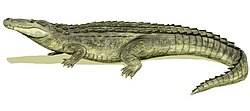| Brasilosuchus Temporal range: Miocene, | |
|---|---|
| Scientific classification | |
| Domain: | Eukaryota |
| Kingdom: | Animalia |
| Phylum: | Chordata |
| Class: | Reptilia |
| Clade: | Archosauromorpha |
| Clade: | Archosauriformes |
| Order: | Crocodilia |
| Family: | Gavialidae |
| Genus: | † Brasilosuchus Souza-Filho & Bocquentin-Villanueva, 1989 |
| Species: | †B. mendesi |
| Binomial name | |
| †Brasilosuchus mendesi Souza-Filho & Bocquentin-Villanueva, 1989 | |
Brasilosuchus is an extinct monospecific genus of crocodilian that lived during the Miocene of Brazil. It contains one species, Brasilosuchus mendesi, named by Jonas Souza-Filho and Jean Bocquentin-Villanueva in 1989. They subsequently re-identified it as a species of Charactosuchus in a 1993 conference abstract, but this conclusion has not been accepted since it was not published. Along with Charactosuchus, it is possibly a member of Tomistominae, but they have not been included in a phylogenetic analysis. If this interpretation is correct, then they would have originated from North American ancestors in the first dispersal of the group into the Americas. [1]


